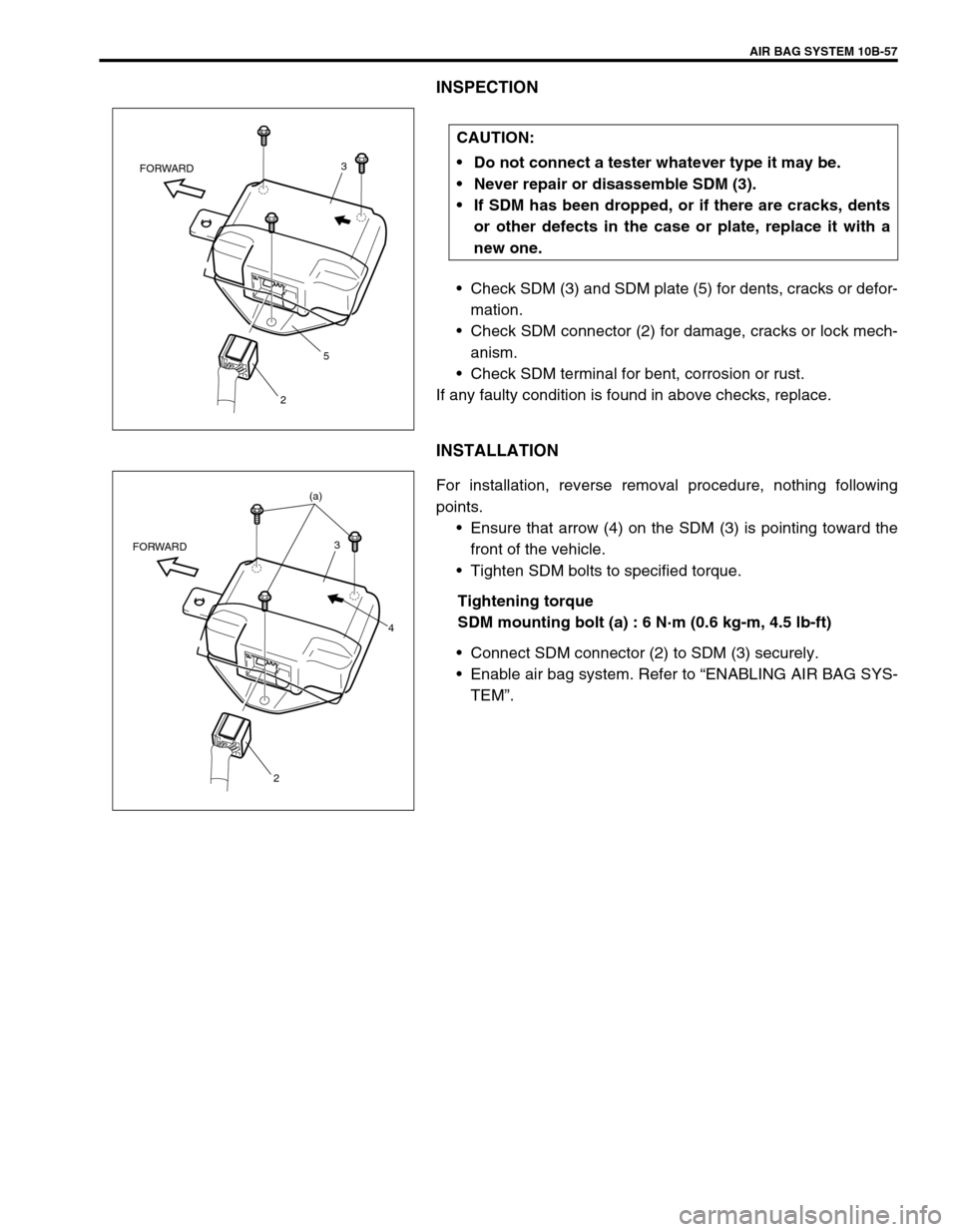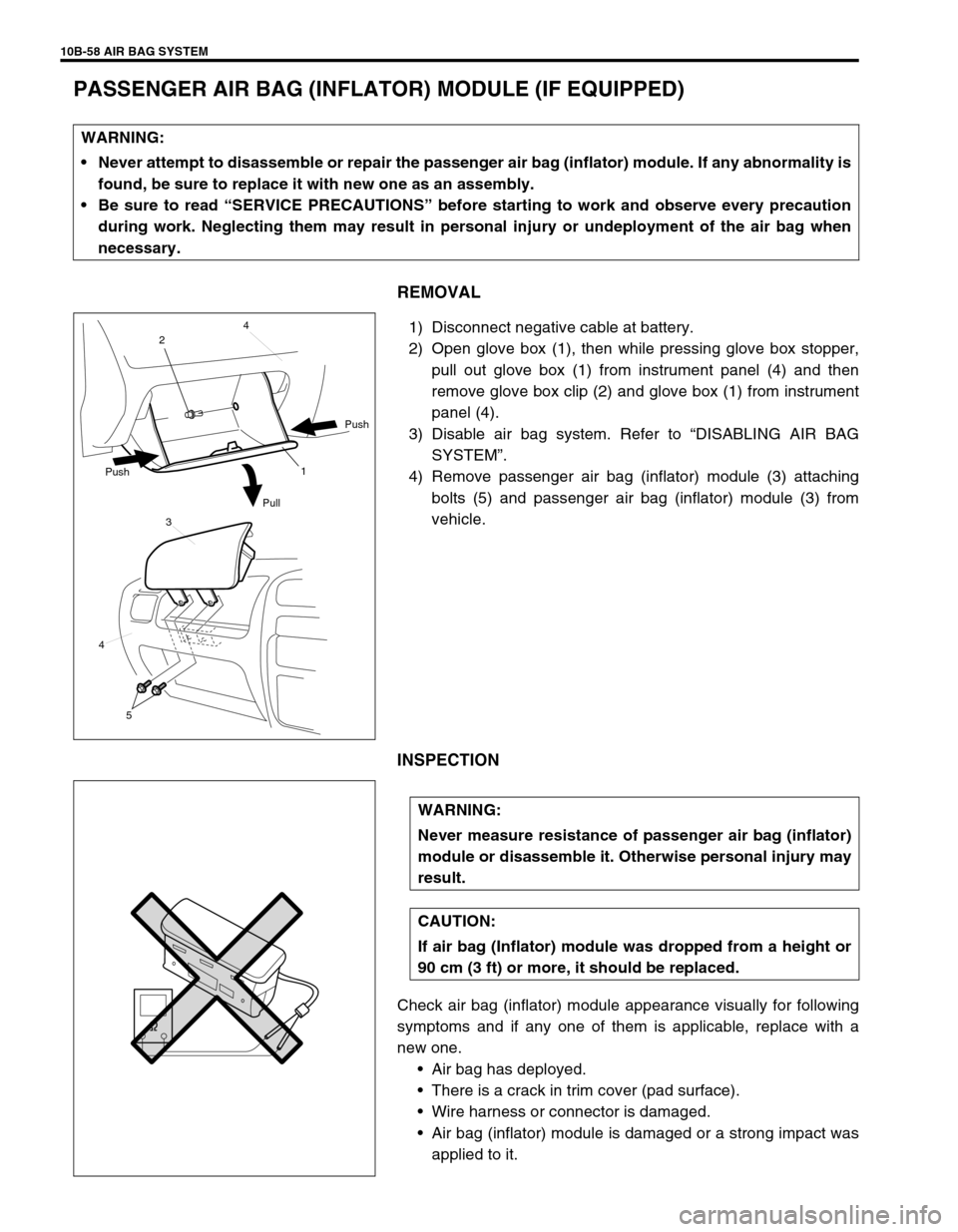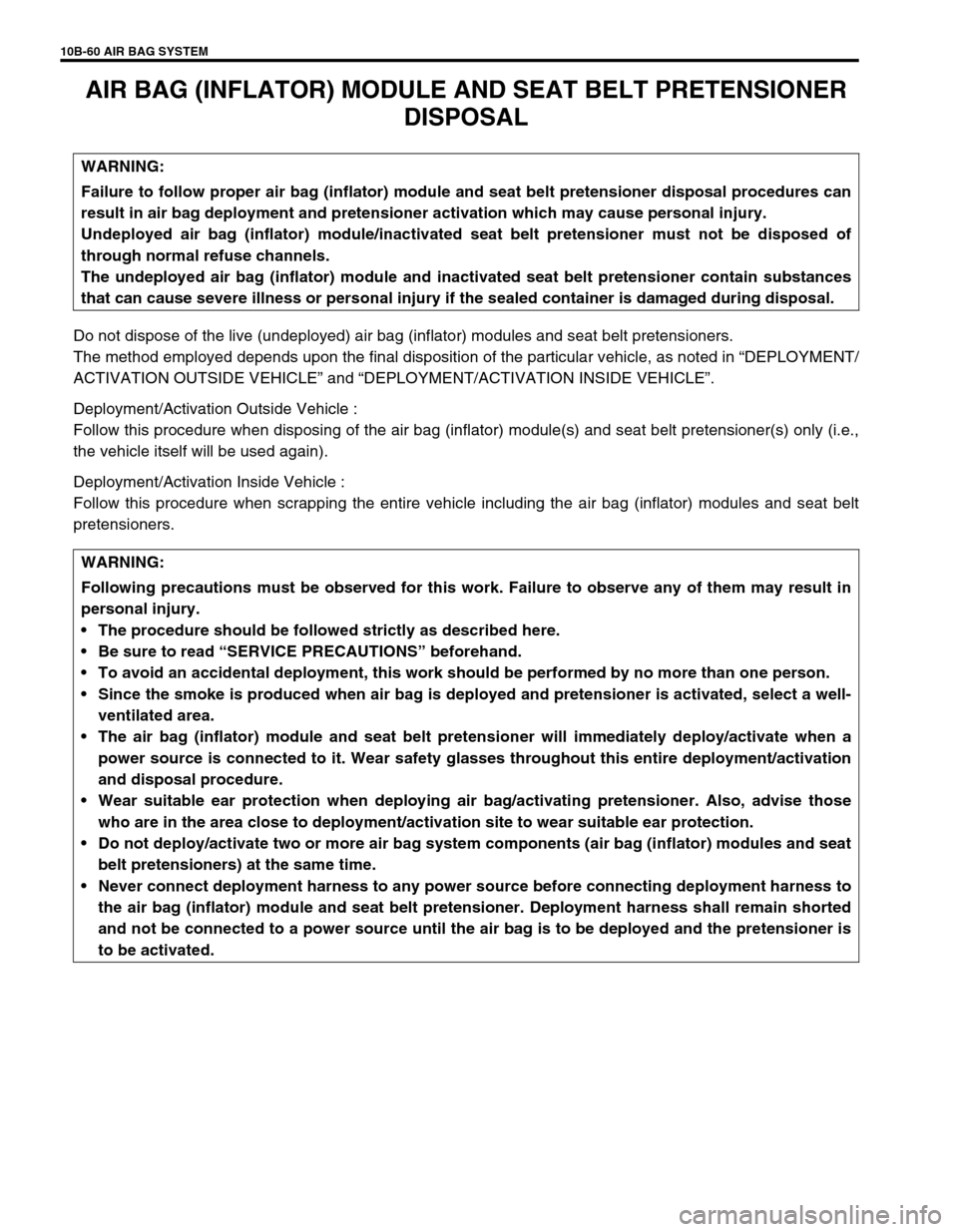SUZUKI SWIFT 2000 1.G Transmission Service Workshop Manual
Manufacturer: SUZUKI, Model Year: 2000, Model line: SWIFT, Model: SUZUKI SWIFT 2000 1.GPages: 447, PDF Size: 10.54 MB
Page 431 of 447

AIR BAG SYSTEM 10B-57
INSPECTION
Check SDM (3) and SDM plate (5) for dents, cracks or defor-
mation.
Check SDM connector (2) for damage, cracks or lock mech-
anism.
Check SDM terminal for bent, corrosion or rust.
If any faulty condition is found in above checks, replace.
INSTALLATION
For installation, reverse removal procedure, nothing following
points.
Ensure that arrow (4) on the SDM (3) is pointing toward the
front of the vehicle.
Tighten SDM bolts to specified torque.
Tightening torque
SDM mounting bolt (a) : 6 N·m (0.6 kg-m, 4.5 lb-ft)
Connect SDM connector (2) to SDM (3) securely.
Enable air bag system. Refer to “ENABLING AIR BAG SYS-
TEM”. CAUTION:
Do not connect a tester whatever type it may be.
Never repair or disassemble SDM (3).
If SDM has been dropped, or if there are cracks, dents
or other defects in the case or plate, replace it with a
new one.
3
5
2 FORWARD
(a)
3
4
2 FORWARD
Page 432 of 447

10B-58 AIR BAG SYSTEM
PASSENGER AIR BAG (INFLATOR) MODULE (IF EQUIPPED)
REMOVAL
1) Disconnect negative cable at battery.
2) Open glove box (1), then while pressing glove box stopper,
pull out glove box (1) from instrument panel (4) and then
remove glove box clip (2) and glove box (1) from instrument
panel (4).
3) Disable air bag system. Refer to “DISABLING AIR BAG
SYSTEM”.
4) Remove passenger air bag (inflator) module (3) attaching
bolts (5) and passenger air bag (inflator) module (3) from
vehicle.
INSPECTION
Check air bag (inflator) module appearance visually for following
symptoms and if any one of them is applicable, replace with a
new one.
Air bag has deployed.
There is a crack in trim cover (pad surface).
Wire harness or connector is damaged.
Air bag (inflator) module is damaged or a strong impact was
applied to it. WARNING:
Never attempt to disassemble or repair the passenger air bag (inflator) module. If any abnormality is
found, be sure to replace it with new one as an assembly.
Be sure to read “SERVICE PRECAUTIONS” before starting to work and observe every precaution
during work. Neglecting them may result in personal injury or undeployment of the air bag when
necessary.
1 24
Push
Pull Push
3
4
5
WARNING:
Never measure resistance of passenger air bag (inflator)
module or disassemble it. Otherwise personal injury may
result.
CAUTION:
If air bag (Inflator) module was dropped from a height or
90 cm (3 ft) or more, it should be replaced.
Page 433 of 447

AIR BAG SYSTEM 10B-59
INSTALLATION
1) Install passenger air bag (inflator) module (1) to instrument
panel (2).
2) Tighten passenger air bag (inflator) module attaching bolts
to specified torque.
Tightening torque
Passenger air bag (inflator) module mounting bolt
(a) : 23 N·m (2.3 kg-m, 16.5 lb-ft)
3) Connect negative cable to battery.
4) Enable air bag system. Refer to “ENABLING AIR BAG SYS-
TEM”.
DRIVER AIR BAG (INFLATOR) MODULE
Refer to “DRIVER AIR BAG (INFLATOR) MODULE” in SECTION
3C for removal, inspection and installation.
CONTACT COIL AND COMBINATION SWITCH
ASSEMBLY
Refer to “CONTACT COIL AND COMBINATION SWITCH
ASSEMBLY” in SECTION 3C for removal, inspection and installa-
tion.
SEAT BELT PRETENSIONER (IF EQUIPPED)
Refer to “FRONT SEAT BELT WITH PRETENSIONER” in SEC-
TION 10 for removal, inspection and installation.
1
2
(a)
Page 434 of 447

10B-60 AIR BAG SYSTEM
AIR BAG (INFLATOR) MODULE AND SEAT BELT PRETENSIONER
DISPOSAL
Do not dispose of the live (undeployed) air bag (inflator) modules and seat belt pretensioners.
The method employed depends upon the final disposition of the particular vehicle, as noted in “DEPLOYMENT/
ACTIVATION OUTSIDE VEHICLE” and “DEPLOYMENT/ACTIVATION INSIDE VEHICLE”.
Deployment/Activation Outside Vehicle :
Follow this procedure when disposing of the air bag (inflator) module(s) and seat belt pretensioner(s) only (i.e.,
the vehicle itself will be used again).
Deployment/Activation Inside Vehicle :
Follow this procedure when scrapping the entire vehicle including the air bag (inflator) modules and seat belt
pretensioners.WARNING:
Failure to follow proper air bag (inflator) module and seat belt pretensioner disposal procedures can
result in air bag deployment and pretensioner activation which may cause personal injury.
Undeployed air bag (inflator) module/inactivated seat belt pretensioner must not be disposed of
through normal refuse channels.
The undeployed air bag (inflator) module and inactivated seat belt pretensioner contain substances
that can cause severe illness or personal injury if the sealed container is damaged during disposal.
WARNING:
Following precautions must be observed for this work. Failure to observe any of them may result in
personal injury.
The procedure should be followed strictly as described here.
Be sure to read “SERVICE PRECAUTIONS” beforehand.
To avoid an accidental deployment, this work should be performed by no more than one person.
Since the smoke is produced when air bag is deployed and pretensioner is activated, select a well-
ventilated area.
The air bag (inflator) module and seat belt pretensioner will immediately deploy/activate when a
power source is connected to it. Wear safety glasses throughout this entire deployment/activation
and disposal procedure.
Wear suitable ear protection when deploying air bag/activating pretensioner. Also, advise those
who are in the area close to deployment/activation site to wear suitable ear protection.
Do not deploy/activate two or more air bag system components (air bag (inflator) modules and seat
belt pretensioners) at the same time.
Never connect deployment harness to any power source before connecting deployment harness to
the air bag (inflator) module and seat belt pretensioner. Deployment harness shall remain shorted
and not be connected to a power source until the air bag is to be deployed and the pretensioner is
to be activated.
Page 435 of 447

AIR BAG SYSTEM 10B-61
DEPLOYMENT/ACTIVATION OUTSIDE VEHI-
CLE
Use this procedure when the vehicle itself is used again (only the
air bag (inflator) module(s) and seat belt pretensioner(s) are dis-
posed).
1) Turn ignition switch to “LOCK”, position remove key and put
on safety glasses.
2) Check that there is no open, short or damage in special tool
(deployment harness). If any faulty is found, do not use it
and be sure to use new deployment harness.
Special tool
(A) : 09932-75030
3) Short (1) the two deployment harness leads together by fully
seating one banana plug into the other.
4) Remove air bag (inflator) module(s) and seat belt preten-
sioner(s) from vehicle, referring to SECTION 3C, 10B and
10. WARNING:
Deployment harness shall remain shorted and not be
connected to a power source until the air bag is to be
deployed and seat belt pretensioner is to be activated.
WARNING:
Always carry live air bag (inflator) module with trim
cover away from you.
When storing a live air bag (inflator) module or when
leaving a live air bag (inflator) module unattended on a
bench or other surface, always face the bag and trim
cover up and away from the surface. As the live pas-
senger air bag (inflator) module must be placed with its
bag (trim cover) facing up, place it on the workbench
with a slit (1) or use the workbench vise (2) to hold it
securely at its lower mounting bracket (3).
This is necessary so that a free space is provided to
allow the air bag to expand in the unlikely event of
accidental deployment.
Failure to follow procedures may result in personal
injury.
1
3
32
Page 436 of 447
![SUZUKI SWIFT 2000 1.G Transmission Service Workshop Manual 10B-62 AIR BAG SYSTEM
5) Set air bag (inflator) module or seat belt pretensioner as fol-
lows.
[In case of driver air bag (inflator) module]
a) Clear a space on the ground about 185 cm (6 ft) (3) in
d SUZUKI SWIFT 2000 1.G Transmission Service Workshop Manual 10B-62 AIR BAG SYSTEM
5) Set air bag (inflator) module or seat belt pretensioner as fol-
lows.
[In case of driver air bag (inflator) module]
a) Clear a space on the ground about 185 cm (6 ft) (3) in
d](/img/20/7605/w960_7605-435.png)
10B-62 AIR BAG SYSTEM
5) Set air bag (inflator) module or seat belt pretensioner as fol-
lows.
[In case of driver air bag (inflator) module]
a) Clear a space on the ground about 185 cm (6 ft) (3) in
diameter where the driver air bag (inflator) module (1) is to
be deployed. A paved, outdoor location where there is no
activity is preferred. If an outdoor location is not available, a
space on the shop floor where there is no activity and suffi-
cient ventilation is recommended.
Ensure no loose or flammable objects are within the
deployment area.
b) Place the driver air bag (inflator) module (1), with its vinyl
trim cover facing up (2), on the ground in the space just
cleared.
[In case of passenger air bag (inflator) module]
a) Clear a space on the ground about 185 cm (6 ft) (2) in
diameter where the fixture (special tool) with attached air
bag (inflator) module (1) is to be placed for deployment. A
paved outdoor location where there is no activity is pre-
ferred. If an outdoor location is not available, a space on
the shop floor where there is no activity and sufficient venti-
lation is recommended. Ensure that no loose or flammable
objects are within the deployment area.
b) Place special tool (passenger air bag (inflator) module
deployment fixture) on the ground in the space cleared in
step a), if it has not already been placed there.
Special tool
(B) : 09932-75041 WARNING:
For handing and storage of a live seat belt preten-
sioner, select a place where the ambient temperature
below 65
°
°° °C (150
°
°° °F), without high humidity and away
from electric noise.
Never carry the seat belt pretensioner by the wire or
connector of the pretensioner.
When placing a live seat belt pretensioner on the work-
bench or other surface, be sure not to lay it with its
exhaust hole provided side facing down. It is also pro-
hibited to put something on its face with an exhaust
hole or to put a seat belt pretensioner on top of
another.
Otherwise, personal injury may result.
Page 437 of 447

AIR BAG SYSTEM 10B-63
c) Fill plastic reservoir in fixture (special tool) with water or
sand. This is necessary to provide sufficient stabilization of
the fixture during deployment.
d) Attach the passenger air bag (inflator) module in the fixture
(special tool) using mounting attachment, hold-down bolts
and nuts and M8 bolts and nuts (3).
Securely hand-tighten all fastener prior to deployment.
[In case of seat belt pretensioner]
a) Pull out the webbing (2) fully as shown in the figure and cut
it at the root of the pretensioner (retractor assembly) (1) as
shown in the figure.
b) Clear a space on the ground about 185 cm (6 ft) (4) in
diameter where the seat belt pretensioner (retractor assem-
bly) (1) is to be activated. A paved, outdoor location where
there is no activity is preferred. If an outdoor location is not
available, a space on the shop floor where there is no activ-
ity and sufficient ventilation is recommended.
Ensure no loose or flammable objects are within the activa-
tion area.
c) Place the seat belt pretensioner (retractor assembly) (1) as
shown in the figure on the ground in the space just cleared. CAUTION:
Be sure to use the following bolt and nut for fixing
passenger air bag (inflator) module to mounting
attachment.
Size : M8, Strength : 7T
WARNING:
As the drum (3) of the retractor assembly (1) turns very
quickly as soon as the webbing (2) is cut, fix the retractor
assembly (1) with a vise on the workbench and keep your
hands and fingers away from it when cutting the webbing
(2).
Page 438 of 447

10B-64 AIR BAG SYSTEM
6) Stretch the deployment harness from the driver or passen-
ger air bag (inflator) module to its full length 10 m (33 ft) (1).
Special tool
(A) : 09932-75030
7) Place a power source (3) near the shorted end of the deploy-
ment harness. Recommended application: 12 Volts mini-
mum, 2 amps minimum. A vehicle battery is suggested.
8) Verify that the area around the air bag (inflator) module or
seat belt pretensioner is clear of all people and loose or flam-
mable objects.
9) Verify setting condition of air bag (inflator) module or preten-
sioner as follows.
[In case of driver air bag (inflater) module]
Verify that the driver air bag (inflator) module is resting with
its vinyl trim cover facing up.
[In case of passenger air bag (inflator) module]
Verify that the passenger air bag (inflator) module is firmly
and properly secured in passenger air bag (inflator) module
deployment fixture (special tool).
[In case of seat belt pretensioner]
Verify that the seat belt pretensioner, is placed as shown in
the figure on the ground in the space just cleared.
10) Connect (2) the air bag (inflator) module or seat belt preten-
sioner to the deployment harness connector and lock con-
nector with lock lever.
11) Notify all people in the immediate area that you intend to
deploy/activate the air bag (inflator) module or seat belt pre-
tensioner.
NOTE:
When the air bag deploys and the pretensioner acti-
vates, the rapid gas expansion will create a substantial
report. Wear suitable ear protection. Notify all people
in the immediate area that you intend to deploy the air
bag (inflator) module or activate the seat belt preten-
sioner and suitable ear protection should be worn.
When the driver air bag deploys and the pretensioner
activates, driver air bag (inflator) module and preten-
sioner (retractor assembly) may jump about 30 cm (1
ft) vertically. This is a normal reaction of them to the
force of the rapid gas expansion inside the air bag and
pretensioner.
After the air bag (inflator) module has been deployed,
the surface of the air bag may contain a powdery resi-
due. This powder consists primarily of cornstarch
(used to lubricate the bag as it inflates) and by-prod-
ucts of the chemical reaction.
Page 439 of 447

AIR BAG SYSTEM 10B-65
12) Separate (1) the two banana plugs on the deployment har-
ness.
13) Connect the deployment harness to the power source (12V
vehicle battery) (2) to immediately deploy/activate the air
bag or seat belt pretensioner.
14) Disconnect the deployment harness from power source (12V
vehicle battery) (2) and short (3) the two deployment har-
ness leads together by fully seating one banana plug into the
other.
15) In the unlikely event that the air bag (inflator) module or seat
belt pretensioner did not deploy/activate after following these
procedures, proceed immediately with Steps 20) through
23). If the air bag (inflator) module or the seat belt preten-
sioner did deploy/activate, proceed with Steps 16) through
19).
16) Put on a pair of shop gloves to protect your hands from pos-
sible irritation and heat when handling the deployed air bag
(inflator) module and the activated seat belt pretensioner.
17) Disconnect the deployment harness from the air bag (infla-
tor) module and the seat belt pretensioner as soon after
deployment/activation as possible.
This will prevent damage to the deployment harness due to
possible contact with the hot air bag (inflator) module and
seat belt pretentioner. The deployment harness are
designed to be reused. They should, however, be inspected
for damage after each deployment/activation and replaced it
if necessary. WARNING:
After deployment/activation, the metal surfaces of the
air bag (inflator) module and the seat belt pretensioner
will be very hot. Do not touch the metal areas of them
for about 30 minutes after deployment/activation.
Do not place the deployed air bag (inflator) module and
the activated seat belt pretensioner near any flamma-
ble objects.
Do not apply water, oil, etc. to deployed air bag (infla-
tor) module and activated seat belt pretensioner.
If the deployed air bag (inflator) module and the acti-
vated seat belt pretensioner must be moved before it is
cool, wear gloves and handle it by using nonmetal
material such as the air bag, webbing and vinyl trim.
Failure to follow procedures may result in fire or per-
sonal injury.
1
2
3
Page 440 of 447

10B-66 AIR BAG SYSTEM
18) Dispose of the deployed air bag (inflator) module and the
activated seat belt pretensioner through normal refuse chan-
nels after it has cooled for at least 10 minutes and tightly
seal the air bag (inflator) module and the seat belt preten-
sioner in a strong vinyl bag. (Refer to “DEPLOYED AIR BAG
(INFLATOR) MODULE AND ACTIVATED SEAT BELT PRE-
TENSIONER DISPOSAL” in detail.)
19) Wash your hands with mild soap and water afterward.
20) Ensure that the deployment harness has been disconnected
from the power source and that its two banana plugs have
been shorted together by fully seating one banana plug into
the other.
21) Disconnect the deployment harness from the air bag (infla-
tor) module and the seat belt pretensioner.
22) Temporarily store air bag (inflator) module or seat belt pre-
tensioner.
[For driver and passenger air bag (inflator) modules]
Temporarily store the air bag (inflator) module with its vinyl
trim cover facing up, away from the surface upon which it
rests. Refer to “SERVICE PRECAUTIONS” for details.
[For seat belt pretensioner]
When temporarily strong the seat belt pretensioner, be sure
NOT to face its exhaust hole provided side down. It must
face up. Refer to “SERVICE PRECAUTIONS” for details.
23) Contact your local distributor for further assistance.
NOTE:
The remaining steps are to be followed in the unlikely
event that the air bag (inflator) module did not deploy or
the seat belt pretensioner did not activate after following
these procedures.